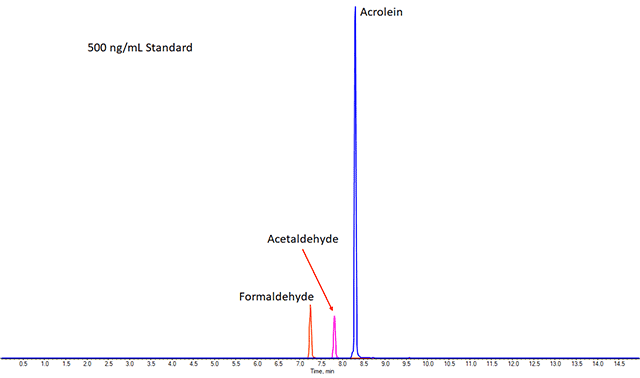Measured Analytes
- Acrolein
- Acetaldehyde
- Formaldehyde
Chromatography
Liquid chromatography tandem mass spectrometry (LC-MS) was carried out with a Shimadzu Prominence HPLC system and SCIEX 6500 QTRAP mass spectrometer using APCI negative ionization. An aliquot of 10 µl of each sample was injected onto an Synergi Polar-RP C18 250 x 2.0 mm column at 40oC for gradient separation. Mobile phases were: A, ddH2O with 0.1% Formic Acid; and B, Acetonitrile with 0.1% Formic Acid. Gradient schedule started at 5%B for 1 min and was linearly increased to 100%B at 10 minutes with a 30 second at 100%B. At 10.5 minutes the gradient was returned to starting conditions and allowed to re-equilibrate until 15.0 minutes. The flow rate was 300µL/min.

Extraction Protocols:
Extraction protocols for sample processing are dependent on the matrices involved. Consultation required prior to choosing a specific method.
Preparation of the dinitrophenylhydrazone derivatives: To perform derivatization with DNPH, a procedure adapted from the literature was followed. Briefly, DNPH (50 mg) was dissolved in 20 mL of acetonitrile and acidified with 0.4 mL of formic acid. The DNPH solution (12 mM) was stable for 1 week when stored at 4°C. Derivatization of aldehydes was performed by mixing 100 μL of the standard solutions (samples) with 100 μL of the derivatizing agent and incubating at room temperature for 1 h. Then, 20 μL of derivatized samples were directly injected onto the LC/APCI-MS/MS system. Each sample was injected twice.
References
Method derived from the following
[1] Determination of patterns of biologically relevant aldehydes in exhaled breath condensate of healthy subjects by liquid chromatography/atmospheric chemical ionization tandem mass spectrometry
Roberta Andreoli, Paola Manini, Massimo Corradi, Antonio Mutti, and Wilfried M. A. Niessen
Rapid Commun Mass Spectrom. Author manuscript; available in PMC 2006 May 2.
Published in final edited form as: Rapid Commun Mass Spectrom. 2003; 17(7): 637–645.
Resources
This tab might be populated with additional information like PowerPoint slides from presentations at conferences, class presentations, grant associated links, and other components that would be directly tied to the method.



